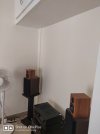1. Every room has its own unique effect on sound. So manufacturers measure their speakers in anechoic chambers. And in real world, with close placement to rear wall, the bass gets augmented to go below the qouted specs also at times.I also have a doubt that the speaker manufacturer mentions the frequency range .But only very few.mentions about on-axis and off-axis response.
Also the lowest frequency claimed,there may be a loss based on your Main listening position.Only by measuring we can able to know what's the real values are.
2. Manufacturers take hundreds of off axis measurements for their speaker to tune their dispersion pattern. A big speaker will be put in a big room and is expected to fill that room. So it can't afford to be very very directive. This will be tuned for wide dispersion. And posting these off axis measurements will only further confuse the end user . So they put it across very cleverly in their positioning notes. Like place them in a equilateral triangle and toe in to fire one meter behind listening position etc...this is where one is expected to start with. And as every room is unique, start playing with the toe in, and distance till you find what suits your ears best.
I've heard a few speakers where I had the singer in the room or the drummer in the room feel.Appreciate any opinions you may have .
Many reviews mention something similar to this in spkr reviews "the singer is in the room, i can almost touch the singer, and the players/instrument's are placed in space and also clearly separated.
This assumes the upstream equipment is of suitable quality to deliver this experience.
calls out some of these .
The spkrs i use Wharf 11.2,Xavian with RN803,PMA600NE and DNP800NE ,mogami and audioquest spkr cables,Amazon basic ICs cables get me to a nice center stage and some separation. 11.2 at low volume listening is very satisfactory as the bass ,mid/bass is rendered well to my ears. Its entirely possible with this config the above soundstage is not a fair expectation. A fairly good and better amp PMA1600NE is on the way.
From user experience which spkrs /brand offer this ? Maybe is that the reason that L3/5A is popular . competitors in the top range of Dynaudio,Dali ,Revel,Wharf and others seem to offer the entire soundstage experience.
Just validating my thinking....
Option 1 : If i dont chase low-freq 30-40Hz delivery.The situation iam in as per my understanding to get closer to the ideal soundstage delivery .(Assume competant upstream equipement).Branded,high end models that also may be high priced .
1. BS/Standmounter : Go for L3/5A or designs inspired by LS3/5A . ( excludes clones )
2. BS/Standmounter : Go for higher end models in a brand ( Dali Menuet , Revel ,DBR 62 ( is a gem as per audiosciencereview .com ) and other equivalents)
Option 2 : If low-freq 40 Hz and below is a must
1. BS/Standmounter : Go and add two subs to BS/standmounters
2. FS speakers : Go for a proper 3ways that dont need a sub
Being a huge sunny Leone fan, I will sell both my kidneys if ever there was a "touch the singer in my room" speaker in the market
On a more serious note to be honest. All those qualities that were mentioned, sound stage, imaging, separation etc must first be there in the recording itself.
Secondly, if the speakers are big relative to the room, then room treatment will definitely be required to preserve the imaging from being destroyed by strong reflections and reverberations.
So getting all the above qualities from smaller speakers in a normal size room, With out room treatment in a near field listening setup. Does not need exotic gear. It just calls for proper placement and positioning of the speakers in that room.
So if the above is your dream presentation then it should not be impossible with your present setup.
As I've said , we all like music to be served by our systems in a manner we like. Mine is mainly scale and dynamics. I like to sink in my chair and be awed by the scale and dynamics and the hard hitting intensity of the presentation, like standing first row in a live amplified concert. Hell we can't make out what the singer is screaming, but the sheer energy of the mayhem will keep us jumping. That's mine
Last edited by a moderator:


